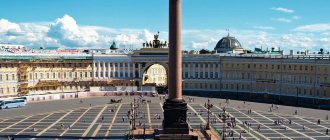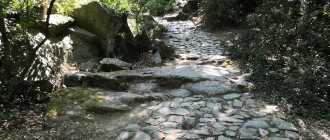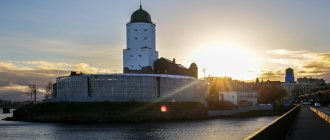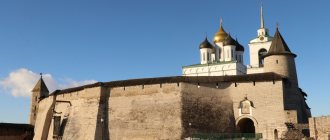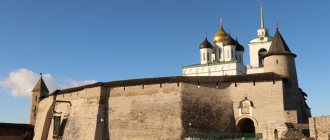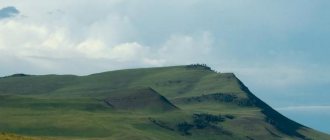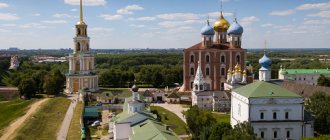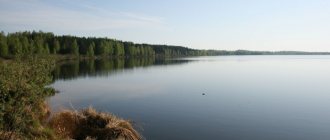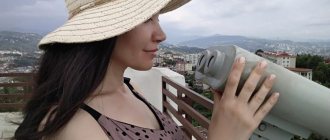Petrodvorets is perhaps one of the most popular suburbs of St. Petersburg, where tourists from all over the world come at any time of the year.
“The Capital of Fountains,” as this city is also called, combines many cultural, historical and natural sites.
The city is located on the shores of the Gulf of Finland, 30 km from St. Petersburg.
Very close to Peterhof - 10 kilometers away - is Lomonosov and its Oranienbaum palace and park ensemble. Be sure to go here; our article will help you plan your visit. And on the way to Peterhof from St. Petersburg - Strelna with its palaces.
Large cascade of fountains, Samson fountain
Anyone who sees the 250-fountain Grand Cascade for the first time with its sculptural frame of 64 images and will not remain indifferent, because it is not just an object of art and some kind of aesthetic pleasure, but also a historical example of greatness and beauty, created by the artists and craftsmen of their time. The figure of “Samson” represents Russia, which defeated Sweden in the long Northern War, which allowed the country, under the leadership of Peter the Great, to reach the Baltic Sea and “cut a window to Europe.” Then Peterhof became an imperial residence, which was formed, designed and built by the best European and Russian architects following the model of the Versailles regular park. Today the Grand Cascade is the artistic embodiment of Peter’s dream of Great Russia, which he built and bequeathed to his descendants.
Dozens of gilded figures and a fountain extravaganza, making you forget about the bustle of the world, do not let you go and you want to immerse yourself again and again in the sound of water and the shine of drops on the gold of sculptures framed by the majestic buildings of the Great Peterhof Palace, rising on the terrace above the Great Cascade. It also contains grottoes, which in appearance cannot be distinguished from natural ones. The Great Cascade is fed from the Square Ponds of the Upper Garden thanks to an engineered water supply system that has existed for three centuries.
All this brilliance was created by various architects and sculptors: I. Braunstein, J.-B. Leblon, N. Michetti, M. G. Zemtsov, F. Vassu, K. Osner, among whom it is worth highlighting B. Rastrelli, who first created the figure of Samson in 1735. The hydraulic structures were carried out under the guidance of engineers P. Sualem, Tuvolkov, brothers Barratini. In 1802, sculptor M. Kozlovsky and architect A. Voronikhin created a new composition to replace the dilapidated one. In 1947, Samson was again put in his place by sculptors N. Mikhailov and V. Simonov, who created a copy from drawings and photographs. In 2011, the updated Samson, after restoration, again began to attract the attention of numerous visitors to Peterhof.
Bath building
In the form in which it exists now, the Bath building was built under Elizaveta Petrovna. In the old days there were steam rooms, showers and bathrooms here. A variety of bath utensils shows how important hygiene and cleanliness of the body were for Russian people.
Throughout its existence, the bath building was repeatedly refurbished to suit the needs of each successive ruler. Today it is the second most popular place among tourists after Petrodvorets.
Great Peterhof Palace
The first two-story version of the Grand Palace was designed by J. B. Leblon, N. Michetti and I. Braunstein. Then it was called “Upper (mountain) chambers.” The width of the building at that time was equal to the Grand Cascade and was built from 1715 to 1725. In 1732, according to the design of M. Zemtsov, two galleries were added to the palace. The work was continued by B. Rastrelli in 1745-1755. The building became one floor higher and expanded along the terrace, bordering the Upper Park and the Lower Park. The Grand Palace was built in the style of “Russian” or “Elizabethan” Baroque, although initially it was more reminiscent of “Petrine Baroque”, like the Hermitage and Monplaisir palaces. The palace became the center of the Lower Garden, from which radial alleys radiate, designed by the master of landscape architecture J.B. Leblond, modeled on the parks of Versailles.
The splendor and luxury of the Baroque gave way to more austere decoration at the end of the 18th century. This was due to the fashion for classicism at the court of Catherine the Great. Many rooms of the palace were rebuilt in a new way: the Chesme Hall, the Dining Room, the Throne Room, the Chinese Cabinets (architect J. B. Vallin-Delamot). The interior decoration has undergone changes more than once. In the middle of the 19th century, the architect I. Stackenschneider created a project for the third floor of the Eastern wing, coming up with eight new interior options. Since this work was dedicated to the wedding of Nicholas I of Olga, half of the Grand Palace is still called Olginskaya.
The Grand Palace today has about 30 rooms and halls, many of which have been restored and are available for viewing by tourists. Here you can see with your own eyes the changes of eras, imagine how the royals lived with their entourage, how ladies and gentlemen from high Russian society danced at balls and walked along the palace.
Peterhof Palace and Park Ensemble
Address: Peterhof, st. Razvodnaya, 2 Phone: (10:00-19:00) Website: peterhofmuseum.ru/ How to get there: from the station. metro station "Avtovo" by buses: No. 200, No. 210, or by minibuses T-224, T-300, T-424; from Art. metro station "Leninsky Prospekt" by minibuses T-103, T-420; from Art. metro station "Prospekt Veteranov" on minibuses T-343, T-639B; from the Baltiysky railway station by train to the New Peterhof or Oranienbaum station. Further from the station in New Peterhof, 10 minutes by buses No. 344, No. 348, No. 350, No. 351, No. 352, No. 355, No. 356; in the summer, you can get from the center of St. Petersburg (from the Hermitage, Palace Pier, or the Admiralty) to Peterhof by meteor. Ticket price from 400 rub. one way
The palace and park ensemble of Peterhof was erected under Peter I in the first quarter of the 53th century. Historians call Peterhof a kind of monument in honor of Russia's victories over the Swedes for access to the Baltic Sea. For 200 years, the park was the summer residence of emperors.
Initially, the park began to be built in Strelna. However, over time it became clear that it was impossible to do without special expensive hydraulic structures. Hydraulic engineer B. Minikh was the only one who dared to go against the will of Peter I, proving with the help of his calculations the impossibility of constructing such a complex in Strelna. He advised moving the construction to Peterhof, where the natural landscapes were ideal for such a grandiose project.
Peter I not only took an active part in coordinating the construction of the park and palace, but also personally made some of the drawings of Petrodvorets.
Currently, the park has 4 cascades and 176 fountains. This is a unique engineering structure, which has practically no analogues in the world. The main feature of the entire fountain system is the complete absence of pressure and pumping elements. The movement of water occurs due to the fact that fountains and water reservoirs are located at different levels, the whole system works on the principle of communicating vessels.
In addition to fountains, there are many palaces and museums on the territory of the ensemble, and the park area is divided into Upper and Lower.
The Hermitage pavilion houses the famous lifting table of Peter I. In tsarist times, the pavilion was a meeting place for the emperor and a select circle of people. These meetings were held on the second floor, and the servants always remained on the first floor. So the table was used to change dishes: at the right moment it was lowered to the first floor, the servants changed dishes and plates, and then returned the newly set table to the second floor.
Since imperial times, the royal fish, sturgeon, has been bred in the ponds near the Marly Palace. Previously, it was served at the imperial table, but now fishing for a fee is a kind of entertainment in the Park.
Upper Garden
Opening hours: 9:00-20:00 Cost: Free admission
The Upper Garden has always served as the main entrance to the imperial residence. Historians claim that Peter I himself planned this part of the park. In addition to its ceremonial purpose, during the life of the emperor the garden also served for growing vegetables, fruits, various herbs and medicinal plants, and fish were bred in the ponds. Later, this part of the park was redeveloped more than once.
The peculiarity of the Upper Park is that all fountains, ponds, alleys, rose gardens, sculptures are located in a perfectly symmetrical order. In the center is the main fountain of the Upper Garden - “Neptune”.
Although the area of the Upper Park is much smaller than the Lower Park, it is absolutely not inferior in its beauty and luxury.
Nizhny Park
Opening hours: 9:00-20:00, ticket offices open until 19.30 Cost: 450 rubles
The Lower Park is an example of regular gardens, based on French originals. The peculiarity of such gardens is the symmetrical arrangement of all structures.
There are 2 alley systems leading from the Grand Palace and the Marly Palace. Each of the alleys leads to some kind of palace or fountain. All alleys are decorated with flower arrangements; on the way of tourists there are firecracker fountains, various sculptures, and benches for relaxation.
An interesting attraction in the Lower Park are the joker fountains; they are also called the first attractions of the 18th century. The main fountain-joke is the “Water Road”. At a certain point in time, everyone walking along the alley leading from the Roman fountains is doused with water from 300 jets. The fountain-bench is also interesting: as soon as you sit on them, you will immediately be doused with streams of water gushing from the stones right in front of the benches.
A ticket to the Lower Park requires a ONE-TIME visit! To return to the territory of the Lower Park (for example, to the meteor) after leaving its boundaries, you must re-purchase an entrance ticket. The special entrance price is valid on weekdays from 17:45, on weekends and holidays from 18:45. Opening hours on holidays: from 09:00 to 20:00
Great Peterhof Palace
Opening hours: 10:30-19:00, entrance to the museum until 18:00, ticket office: 10:30-17:45 Cost: adult – 450 rubles, children under 16 years old – free
The Great Peterhof Palace is perhaps the most important building in the park. It connects the Upper and Lower Gardens into a single whole, it is from here that the main alleys of the park diverge, and it is at the foot of the palace that the main fountain group is located - the Grand Cascade and the Samson fountain.
Upon entering the Lower Park, guests immediately find themselves on the 300-meter terrace of the Palace, which offers a panoramic view of the entire park.
The majestic palace that tourists see now has changed its appearance for a century and a half. Initially, it was a small two-story building, the width of which did not exceed the width of the Great Cascade, and served for receptions and celebrations. Under Empress Elizabeth Petrovna, the palace was completely rebuilt according to the model of Versailles.
The dance hall of the palace has one peculiarity: the blank walls of the western and northern sides are decorated with mirrored fake windows that reflect the views of the real windows on the opposite side. There is also another story connected with this hall. The project was carried out by the architect Rastrelli. He was ordered to decorate the hall as richly as possible, and he coped with this task, creating mansions that were more luxurious than the Palace of Versailles itself. Empress Elizaveta Petrovna was pleased with the work of the master, but paid him absolutely nothing.
During the Great Patriotic War, the palace was almost completely destroyed. However, already in 1944 work began on its restoration, and already in 1945 the opening of the Lower Park took place.
The palace combines the work of architects from different times and styles. Its majesty, luxury and beauty are not inferior to the best palaces in the world.
Every year at the end of May and mid-September, the park hosts ceremonial opening and closing celebrations of the fountains. These days, the park's operating hours should be checked on the Petrodvorets website. From April 29 to September 29, 2022, the sale of tickets by session is introduced for individual visitors and tourist groups. Box office opening hours for individual visitors: Tue-Fri, Sun: 12:00-14:00, 16:15-17:45; Sat: 12:00-14:00, 16:15-19:45. The last Tuesday of the month is sanitary day.
Grand Cascade and Samson Fountain
Operating mode: 11.00 – 18.00
The Great Cascade is the main fountain structure of Peterhof and one of the most famous buildings in the world. It combines 64 fountains, the central one of which is the Samson Tearing the Lion's Mouth fountain. According to the idea of Peter I, the Great Cascade symbolized the victory of Russia over Sweden and served as the ceremonial end of the sea entry into the residence. In the sculpture "Samson Tearing the Lion's Mouth", the Lion personifies Sweden, since this is the animal depicted on the country's coat of arms.
During the Great Patriotic War of 1941-45. the park and palace were practically destroyed, many pieces of art were irretrievably stolen, one of them was the figure of Samson. However, the architects were able to restore it to its original form.
After the appearance of the Grand Palace and its parks, the most popular profession in the Russian Empire became that of a fountain caretaker.
The cascade is decorated with many marble and gilded bronze statues, animal figures, vases, bas-reliefs, and busts. They all make up a single composition. An interesting fact is that some masters working on marine-themed sculptures had no idea what marine life looked like. That is why the dolphins of the ensemble look more like fairy-tale fish.
Recently, entrance to the Lower and Upper Grottoes of the Great Cascade has been opened for park visitors. They were created to strengthen the mountain on which the Grand Palace and the main fountain ensemble are located. However, the interior decoration of the grottoes is very unusual and beautiful: stone walls are complemented by various sculptures and fountains. In tsarist times, the owners and guests of Peterhof rested here. In the lower grotto, according to the idea of Peter I, the “splash table” and “water curtains” fountains, popular in the 18th century, were installed.
Every day at 11:00 - the ceremonial launch of the fountains of the Grand Cascade to the music of Gliere's "Hymn to the Great City"
View of the Gulf of Finland
For many tourists visiting Peterhof for the first time, the view of the Gulf of Finland from the coast of the Lower Park is a revelation. If the weather is good, the bay sparkles with small waves reflecting the sunlight. From here you can see the Marine Station on Vasilyevsky Island and the silhouettes of ships on the horizon. You can get to Peterhof by Meteor, a hydrofoil that takes you past the city traffic jams straight to the palaces and fountains. The only disadvantage of such a trip is the cost (750-800 rubles). But how many pleasant impressions there are from a boat trip!
The Gulf of Finland can be leaden, cold and uncomfortable, or it can be cheerful and kind, it all depends on the weather and your mood! After visiting historical attractions, many tourists happily sit down at the tables of a summer cafe near the Sea Canal and the Standart restaurant, where they can have a snack, eat ice cream or drink a cup of coffee. Other visitors to the park sit right on the shore and drink tea from thermoses, snacking on sandwiches.
Outdoor recreation in such a beautiful place is worth a lot! Children and adults always have lasting impressions. Standing on the shore of the Gulf of Finland, one can imagine cities and countries lying beyond the mirror of water and other people who also look into the distance through the waves, like Assol at the scarlet sails of Gray's ship.
What to see in Peterhof on your own in 1-2 days
The route for a one-day stay in Peterhof is quite traditional. Start your sightseeing tour from the Upper Park
(between Razvodnaya and Pravlenskaya streets, to the right of St. Petersburg Avenue), which leads to
the Great Peterhof Palace
and its Lower Park.
Then at the box office you buy a ticket to the territory of the Lower Park
, where you need to separately purchase a ticket to the Grand Palace (Petrodvorets).
Upper Park - the beginning of the route
If it is clear that standing in line to visit the palace will take too much time, then it is better to immediately go for a walk in the Lower Park
.
The park is divided by the Sea Canal
into two parts, each of which needs to be walked around; each contains a small palace (
Marly
and
Monplaisir
), which are very, very desirable to explore.
Sea canal in Nizhny Park
If you have time and energy left after visiting the Lower Park, you can try to get to the Grand Palace
. In addition, you can explore the nearby Alexandria Park and the Kolonistsky Park located opposite the Upper Park, across St. Petersburg Avenue. Both of these parks have amazing attractions that will pleasantly surprise every tourist.
Petrodvorets
The first place where the main tourist masses go in Peterhof is, of course, the Grand Palace
or Petrodvorets.
Even the huge queue to visit it does not frighten those who want to get acquainted with the luxury of the palace halls. The Grand Palace is a striking example of Rastrell's Baroque
, that period in the development of architecture when pomp, pomp, luxury and splendor were in fashion - the splendor of the
18th century
! The design and interiors of the halls do not repeat each other, the shine of the gilding is stunning, the beauty and wealth are mesmerizing.
Ballroom of the Great Peterhof Palace
Petrodvorets, stretched along a high ridge along the Gulf of Finland, is surrounded on all sides by park areas
.
To the south is the Upper Park, to the north is the Lower Park. Both parks are drawn with strict parallels and perpendiculars of straight alleys, decorated with fountains and sculptures. But if the Upper Park
is a prelude, then
the Lower Park
is already a full-fledged sound of a beautiful landscape-park orchestra with the allegro of its fountain cascades and with the syncopations of its architectural structures -
Marly
,
Monplaisir
, the Hermitage, etc.
Monplaisir Palace of the Lower Park
The level of emotions when visiting the Petrodvorets architectural and park ensemble can go off scale, so in order to reduce the excitement a little and immerse yourself in an atmosphere that is calmer and closer to nature, we suggest visiting the nearby landscape Park Alexandria.
Alexandria Park
The architectural and park area of Alexandria Park dates back to the second quarter and mid-19th century
.
These are different times and different priorities for summer holidays. Even kings wanted peace and solitude, a quiet home environment
and the absence of palace ceremony.
Therefore, under Nicholas the First the Cottage Palace
, and Alexander the Second subsequently created
the Farmers' Palace
(moreover, rebuilt from a real cow farm!). The Lower Dacha is being built for the family of Nicholas II.
Palace Cottage of Nicholas the First
It is very interesting to see the preserved and restored mini-palaces of royalty, to learn about their summer pastimes, and a walk through the landscaped, naturally formed park will be very pleasant and easy.
Colonial Park
A little-known, but very, very unusual hydropark of Peterhof
— Kolonistsky, created during the time of Nicholas the First, will amaze not only with the picturesque landscape, but also with unusual architectural structures - pavilions located on the islands of
Olga's Pond
. They were built there not for living, but for a pleasant stay in the Roman-Italian architectural and park atmosphere. Colonist Park with its Tsaritsyn and Olga pavilions will be an unforgettable highlight of your stay in Peterhof.
Meadow Park
If you go south from Kolonistsky Park along the Olginsky Canal, you can reach another landscape park - Lugovoy
.
19th century parkland
, which was created in parallel with Kolonistsky Park.
Several architectural structures were built among the picturesque tracts of trees and shrubs. Ozerki Pavilion
or Pink (architect A. Stackenschneider) played a dominant architectural role in the park composition. Unfortunately, after heavy destruction during the war, the pavilion has not yet been restored.
The Belvedere was built for imperial picnics.
, a massive two-story pavilion with a colonnade and sculptures. During the Soviet period, the Belvedere building was used as a recreation center, and today it hosts entertainment events.
Walk through the territory of the former Meadow Park, explore its Big Round
,
Melnichny
and other picturesque ponds and preserved buildings are a very pleasant experience. But this is already a dessert to the main and traditional dishes of Peterhof.
The same applies to the territory of the abandoned English park
, in the English Palace of which Catherine the Second once rested, and today you can only see the ruins of its former greatness.
The site of the former English Palace
Therefore, in order to get acquainted with numerous architectural and landscape monuments, you can safely plan two
, or even
a three-day
stay. If this did not work out, it means that you have a reason to return to this city rich in attractions.
Monplaisir Palace and nearby fountains
This palace became the favorite brainchild of Peter the Great, because he not only rested and worked here, but also participated in its design. The project was implemented by outstanding architects: I. Braunstein, N. Michetti, J. B. Leblon, A. Schlüter. Famous artists and interior specialists worked inside the palace. Everything in the Monplaisir Palace is done functionally and very conveniently, which is what the emperor himself wanted. The second name of the palace, “Dutch House,” was given to it because of the facade, which is very reminiscent of the houses of the Dutch, as Peter I remembered them during his travels through Europe.
Next to the “Monplaisir” there is a composition with fountains and lead sculptures, created according to the design of Nicolo Michetti in 1723, but over time dilapidated and made by the sculptor I. Martos from bronze in 1817. The name “Bells” became popular due to the shape of the flowing water. pedestals of water jets. In the center there is a stone fountain “Sheaf”, along the circumference there are four more fountains with figures of Bacchus, Apollo, Faun, Psyche. These statues were buried during the Great Patriotic War, and after its end, they were restored and put back in their places.
How to get to Peterhof?
From 1944 to 1997 this suburb was called Petrodvorets . Peterhof is incredibly popular not only among tourists who come from all over the world to admire its splendor, but also among St. Petersburg residents. The most convenient way to get to Peterhof in the summer months is by high-speed ship Meteor , which departs from the pier opposite the Winter Palace. The journey will take no more than 30 minutes, during which you can enjoy the views of St. Petersburg and all the delights of a sea voyage.
You can also take the train , which leaves from the Baltic station every hour and will leave you at your destination in 40 minutes.
Avtovo metro station to Peterhof there are buses No. 200 and No. 210 and many minibuses. In general, there are many options, including personal vehicles .
Upper Garden
This is the most accessible corner of Peterhof, because a walk here is free, and the beauty of fountains and alleys, sculptures and ponds can detain a visitor for a long time, leaving no time for other attractions. The Upper Park was created simultaneously with the Lower Park and has approximately the same milestones in its history. This is the first layout under Peter the Great, the creation of ponds and water pipelines to feed the fountains of the Lower Park and the Grand Cascade by the outstanding hydraulic engineer P. Sualem, the layout of gardens and alleys, the design and construction of fountains, the installation of sculptural compositions.
In the Upper Garden (park) there are five fountains with the main one - “Neptune”. “Dubovy” and “Mezheumny” are also very famous, each of which has its own history. The layout of the Upper Garden as a French regular park was carried out by J. B. Leblon.
The fountains of the Square Ponds are decorated with sculptures “Summer” and “Spring”, and the statues of Neptune and Apollo Belvedere, created in 1736, bring masculinity to the ensemble of the Upper Park. Tourists love to see the sculptural group of gods and goddesses of the ancient Greek pantheon: “Zephyr”, “Pomona”, Vertumnus”, “Flora”, created by G. Bonazza in 1757. The sculptural composition of the Italian Venus with six dolphins adorns that part of the Upper Park, behind which the magnificent Peter and Paul Church, which is part of the Grand Palace complex, is visible.
Sightseeing tours to the best places
What to see in Peterhof - you know, it remains to figure out how to organize it. You can get there on your own, by train from the Baltic Station, by car or by minibus. But this is not as interesting as a professionally organized excursion with a good guide. Therefore, Sputnik offers the most convenient way to search for current trips.
Check out the list and choose the route to Peterhof that interests you. Book an excursion and pay for it directly on the website.
A couple of clicks - and you will find yourself in a city that has become an integral part of the historical and cultural heritage and popular excursion tours of St. Petersburg!
Grottoes of the Grand Cascade
The Lower and Upper Grottoes were built between 1716 and 1720 according to the design of architects J. B. Leblon, I. F. Braunstein, N. Michetti. These grottoes represent the center of the Grand Cascade; they are decorated with fountains, sculptures, and lined with tuff. A large grotto with a facade of five arches decorated with mascarons serves as the basis for a terrace leading to the Small Grotto. A marble balustrade with bronze tritons sitting on it serves as the border of the grottoes. The lower grotto is a hall with a high ceiling and a marble sculpture by P. Baratta, emphasizing the splendor of the room. There are also gilded copies of sculptures by ancient authors, created in the 19th century. There is a “Basket” fountain on the site.
By visiting the grottoes, you can learn the history of the creation of the Grand Cascade fountains, as well as the engineering solutions that are used here.
Church of Peter and Paul
The history of the Peter and Paul Cathedral in Peterhof is not as eventful as that of other architectural masterpieces, because this building was erected only at the beginning of the twentieth century at the request of the head of the clergy of the court, Ioann Yanyshev, who in time saw the need to build a new church in Peterhof due to lack of space in existing churches. After consideration of the request at the highest level, design (architect Nikolai Sultanov), laying the foundation, construction (led by architect Vasily Kosyakov), decoration and painting of the cathedral by the best artists of St. Petersburg and Palekh, 13 long years passed, and only in 1905 the temple was consecrated by the same protopresbyter John Yanyshev.
The history of the temple in Soviet times is a series of positive and negative events, thanks to which it still retained its original appearance. Today the cathedral is a functioning Orthodox church with a parochial school and its own charitable foundation. Its interior decoration is made in several artistic directions, but on the outside it is a typical architectural ensemble in the neo-Russian style, pyramidal and rising to the sky to a height of 70 m. Everything here is done rationally and functionally! The temple is surrounded by a covered gallery with interior spaces for the blessing of gifts. A vestibule was added as dressing rooms, and separate staircases ascended to the choir. The beautiful appearance is completed by a hipped belfry, a chapel with a stone arched portal, as well as two porches of the main entrance to the cathedral. Another frequently visited place in the temple is the observation deck, which can be accessed by paying a small amount as a donation. Most often, tourist groups following a specific excursion route are allowed onto the site. The view from the site in good weather is wonderful - this is Kronstadt, part of Peterhof with the Upper Park and Olga's Pond, part of St. Petersburg, Babigon, the Gulf of Finland.
Museum complex Islands
Address: Peterhof, st. Borodacheva Telephone: How to get there: You need to take a minibus or bus going to Peterhof (the numbers are indicated at the address of the Peterhof Palace and Park Ensemble), to the Torgovaya Ploshchad stop, then cross to the other side and follow along the Krasnoprudsky Canal to Tsaritsinskaya Street, then walk along Tsaritsinskaya Street until it intersects with Borodacheva Street and follow it until the entrance to the museum complex. Opening hours: daily 10:30-18:00, entrance to the museum until 16:45, ticket office open until 16:45 Cost: adult ticket 450 rubles, children under 16 years old free Entrance ticket to the park without visiting the Pavilions - 150 rubles. for all categories of citizens
Artificial islands on the Olga Pond of Peterhof were created by order of Nicholas I. According to the emperor's idea, the islands were to become secluded corners for his wife Alexandra Feodorovna and daughter Olga. The islands are cozy gardens on the banks of a pond with pavilions that are reminiscent of 18th-century villas and country houses in Southern Italy.
The Tsaritsyn and Olgin pavilions are located on the islands.
Architect Andrei Ivanovich Stackenschneider based the design of the Tsarina Pavilion on the appearance of ancient Roman houses discovered during excavations in Pompeii. The pavilion is an example of luxury. The garden contains many sculptures, a swimming pool with fountains, and the pavilion itself, a small one-story building with an attached three-story observation tower, is decorated with marble of different shades and polished stone.
Holguin Pavilion, built for the imperial daughter as a gift for her wedding day with Prince Charles of Württemberg, is made in the style of villas on the island of Sicily.
This is a three-story tower with a terrace and stairs going down directly to the water. In tsarist times, gondolas and boats moored here.
The facade of the pavilion is decorated with bas-reliefs, balconies, niches with marble busts, and water drains in the form of dragons. The garden is no less beautiful than the pavilion itself: the illusion of a Garden of Eden was created not only by numerous plants and flowers, but also by peacocks strolling through the park.
Inside, the decoration of the Pavilion is quite restrained, but no less beautiful. The upper terrace of the observation tower offers a picturesque view of Peterhof.
The park is closed in winter. The Islands museum complex opens to the public on May 27, 2022! The ticket price includes admission to both pavilions. The museum is closed during rain and high humidity.
Alexandria Park
Alexander Park of Peterhof began its development under Peter I, and later became Anna Ioannovna’s residence for hunting and entertainment. The park received the name “Alexandria” already during the reign of Nicholas I, who in 1825 gave this place to his wife, Empress Alexandra Feodorovna, as “Her Majesty’s own dacha Alexandria.”
Unlike other memorable places in Peterhof, “Alexandria” has an unusual architectural appearance. Everything here is permeated with neo-Gothic style, even the Orthodox Church of Alexander Nevsky looks like a Gothic chapel. All buildings were designed and executed by architects A. Menelas, A. I. Stackenschneider, K.F. Schinkel in the 30s of the 19th century by order of the imperial family. Today here you can see a number of buildings in the neo-Gothic style dating back to the mid-19th century: the Palace Telegraph Station Museum, the Farmers' Palace, the Chapel with 43 bronze statues (sculptor V.I. Demut-Malinovsky), the Feldjeger House, the Sea Guard, the Palace " Cottage". The Great Ruin Bridge, which is so called because of the ruins of Alexander Menshikov’s palace “Moncourage” that was once located here, is interesting, as well as the “Pergola” bridge, which means “canopy from the sun.”
Nowadays, “Alexandria” serves as a family park, where St. Petersburg residents and guests of the city like to relax, since there are few tourists here compared to the Nizhny Park.
Imperial Bicycle Museum
The sights of Peterhof are not only luxurious palaces and endless shady parks, but also numerous museums. One of them is the Museum of Imperial Bicycles, located in the oldest building of Peterhof. Unfortunately, it is not as popular as the famous Petrodvorets or the Grand Cascade, and visitors do not come here often. However, this is no less interesting.
There are only 12 exhibits on display at the museum - these are bicycles that once belonged to children and adult members of the royal dynasty. The exhibition tells the entire history of this vehicle from its inception to the beginning of the 20th century. Most of the exhibits are children's specimens. The collection is complemented by various accessories - lanterns, horns, cards with a picture of a bicycle, etc. The exhibition will be especially interesting to connoisseurs of Russian history.
Cascade "Chess Mountain"
The cascade, which is called “Chess Mountain” because of the checkerboard pattern of the steps, is located on the most beautiful square in the eastern part of the Lower Park. The cascade is a natural slope of the terrace bordering the Lower Park. Architects I. Braunstein, M. Zemtsov, T. Usov, I. Blank, I. Davydov had a hand in the construction of this cascade. Initially, the cascade was planned as a destroyed fortress tower, then it began to personify the home of the winged dragons that guarded the entrance to the Upper Grotto. Then it began to be called “Dragon Mountain”. “Chess Mountain” is decorated with sculptures of ancient gods, preserved in the ground during the Great Patriotic War. Already in 1953, the cascade was restored and became again similar to the previous one.
Fountains - firecrackers
“Yolochki” - built in 1784 according to the design of architects I. Keizer and F. A. Strelnikov. “Christmas trees” are three metal trees, very similar to real firs, located next to the Greenhouse. In 1951, the firecracker was recreated by a team of fountain master A. Smirnov.
“The Oak” is a joke fountain created in 1735 according to the design and model of B. K. Rastrelli. At first it decorated one of the pools in the Upper Garden, but in 1802 the master F.A. Strelnikov installed the “Oak” not far from Monplaisir Alley, where it is located now. Today, the joke fountain “Dubok” is a real fountain complex of several water extravaganzas, which include a metal trunk, 500 branches-tubes and 2500 leaves. In the post-war years, it was restored using archival documents and one branch with leaves by the masters Lavrentiev (father and son).
The “umbrella” was created as a water cracker in 1796 by the architect F. Brower. The fountain looks like an umbrella and therefore has this name. As soon as the guests gathered under its roof, streams of water began to flow from 164 pipes, hidden behind carved festoons and providing a dense curtain of water. In the 19th century, the fountain began to look like a fly agaric and it was called “Mushroom”. In 1949, restorers decided to return the name “Umbrella,” but many native St. Petersburg residents still call this cracker “Mushroom.”
The “Water Road” is located on Monplaisir Alley next to the Roman fountains. This joke fountain has not worked for 280 years, since the reign of Peter the Great, when, by his decree, the architect N. Michetti created the “Water Road”, first launched in 1721. The idea was interesting: 300 water jets suddenly began to shoot from both sides of the path and all those walking were caught in a firecracker shower. Under Peter, this fountain was called the “Mochilnaya Road”. The fountain was restored according to the surviving drawings and descriptions in our time and now it works strictly according to the schedule: 13.00, 14.00, 15.00.
“Sofas” is a joke fountain that began its existence in 1723 according to the design of N. Michetti. This fountain is a trellis structure with lattice legs and backs, on which are mounted triton mascarons, modeled on decorative sculptures of the early 18th century. When approaching the “Sofas” you need to be prepared for the fact that jets of mascaron and a tuff slide under the seat will fall on you, as well as streams of water from tubes built into the area near the “Sofas”. This is the most favorite joke fountain among children visiting Peterhof.
